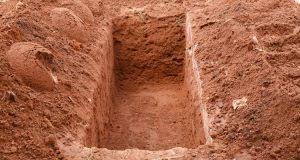A sheet is wrapped around a female dummy to demonstrate the washing and shrouding process for a Muslim burial at the Islamic Society of Greater Charlotte.Credit Tasnim Shamma
When a loved one dies, most of us turn to a funeral home or crematorium to take care of the body. In the Islamic tradition, it’s different. Family members often help wash and bury their bodies within 24 hours. But first, you have to learn how to do it.
WFAE's Tasnim Shamma attended a body-washing class and filed this report.
Welcome to the Islamic Society of Greater Charlotte’s washing room.
The walls are white, there are metal tables ready for bodies and it smells kind of like moth balls. And if you’re a Muslim in Charlotte, your body is almost guaranteed to pass through this room.
The washing room at the Islamic Society of Greater Charlotte is located in the back corner of a multipurpose hall next to the mosque. The hall includes an indoor basketball court where tournaments, funeral prayers, weddings and carnivals are held back to back. Volunteers organize the white sheets they will need to wrap around the body after the wash.Credit Tasnim Shamma
It wasn’t always that way. Local Muslim bodies used to be taken to local funeral homes to be washed. But Zainab Ahmed says they weren’t always culturally sensitive.
"The thing I did not like was the man was handling the Muslim sister without any clothes," Ahmed says. "So that was very painful for me to see. And since then, I would tell the community members here, those on the board, it is a must. It is necessary. We have to have a washing place."
Three years ago, she got her wish. And today, Ahmed teaches Muslims how to wash bodies.
The first step is gathering the materials. You need soap, gloves, a comb, a bucket and yards of white cotton cloth.
Zainab Ahmed instructs Yaseen Valam of the Cemetery Committee to cut yards of white cotton cloth into five pieces to shroud the female dummy. Muslim men only require three pieces of cloth, each 7 x 7 feet.Credit Tasnim Shamma
The dummy for this demo is stuffed with cotton from an old blanket, but it's got a white Styrofoam head with a black wig, long eyelashes, big hips and narrow waist that her teenage son helped make.
Zainab Ahmed's son helped make the dummy out of thermal wear and cotton from an old blanket. Ahmed uses the female dummy during her body-washing classes at local mosques.
Credit Tasnim Shamma
It's placed on the table and covered by a sheet, with the private parts of the body covered by an additional cloth. There are usually two or three other helpers of the same gender, unless it's a spouse. Everyone wears gloves and they pour water into jugs to avoid wasting water.
"We start actually we have the water running and we have the hose that we can wash whatever impurities the body is with, coming from the hospital or whatnot," she says. "You just want to make sure you know, to clean those impurities."
While someone lifts the upper body, one woman presses down on the abdomen to excrete fluids still in the body.
Zainab Ahmed and another volunteer, Khalila Haq demonstrate how they would lift the body and excrete fluids from the abdomen. During the actual wash, the body would be handled carefully and covered by sheets for privacy.
Credit Tasnim Shamma
"The second thing is always to start from the right side. We wash her head with soap and water and then the upper right and then the upper left and then the bottom right," Ahmed says.
This is repeated about three times. Finally, the hair is washed and combed and braided into three braids. Prophet Muhammad taught that a woman's hair should be made into three braids for simplicity in burial.
The dummy's wig is loosened, washed, combed and then made into three braids that will be placed behind her head.
Credit Tasnim Shamma
And during the last wash, camphor is added in the water. It's a white, waxy substance in the shape of small cubes that keeps the body soft.
Camphor is added into the water before the body is shrouded and spread over the forehead, nose, hands, knees and feet — the parts of the body that touch the ground during prayer.Credit Tasnim Shamma
"At the time of burial, the angels are present," Ahmed says. "And it gives a very good smell. Second, it keeps the insects away from the body."
After this final wash, the dummy is dried with a clean towel and dressed with a makeshift skirt, head covering and a sleeveless shirt. Its hands are laid across the chest as they would be during prayer.
The hands of the dummy are crossed as they would be during prayer.
Credit Tasnim Shamma
Finally, the largest piece of cloth is wrapped tightly around the body. The whole process of washing and wrapping the body takes about an hour.
After the sheets are wrapped around the body, they are fastened with makeshift ropes made of the same cloth: one above the head, two around the body and another below the feet. The body is now ready for the funeral prayer and burial.Credit Tasnim Shamma
Like most Jews, Muslims try to avoid embalming their dead, so that the body naturally decomposes into the Earth. So it's important to perform this last ritual wash as soon as possible – usually within 24 hours.
The wash is done for a few reasons. Practically, it's important to get rid of extra fluids that might still be in the body and religiously, it's like the body is getting ready for a final prayer.
Washing the bodies of the dead is considered a collective duty for Muslims. Still, it’s not something that most Muslims readily volunteer to do. Ahmed became an exception 25 years ago when she agreed to help a friend wash a body. Her family didn’t understand.
"My mom said, 'How was it? Everything was OK? Are you fearful?' I said, 'Yes I am fearful.'" she says. "And then she told me, 'Didn't I tell you not to go?' But I gave her the answer: 'You know what mom? If I have to, I will go again.'"
Ahmed says it took her a week to recover from that first experience. Now, she holds classes a few times a year.
"It is a collective obligation on every Muslim. So somebody in the community has to know," she says. "So when you do this, you do this for the sake of God to prepare the body. And this is the closure, this is so close to God. This is how you're going to presented."
Source:http://wfae.org
 Sri lanka Muslims Web Portal Diversity and Inclusiveness
Sri lanka Muslims Web Portal Diversity and Inclusiveness












